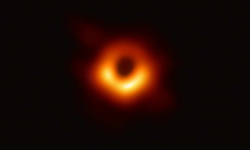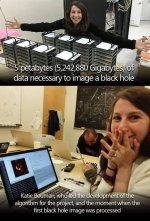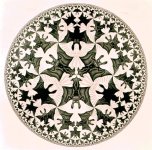-
Features
-
Friends of IIDBFriends Recovering from Religion United Coalition of Reason Infidel Guy
Forums Council of Ex-Muslims Rational Skepticism
Social Networks Internet Infidels Facebook Page IIDB Facebook Group
The Archives IIDB Archive Secular Café Archive
You are using an out of date browser. It may not display this or other websites correctly.
You should upgrade or use an alternative browser.
You should upgrade or use an alternative browser.
Excellent video on black hole imaging
- Thread starter repoman
- Start date
skepticalbip
Contributor
- Joined
- Apr 21, 2004
- Messages
- 7,304
- Basic Beliefs
- Everything we know is wrong (to some degree)
Hey, gotta thank you for the link. I followed a few of his videos and ran into this one that is about as far from a discussion of black holes as possible.... Sorry about that.
I have always been a little uncomfortable with some of the consequences of the Copenhagen interpretation. This video offered an alternate interpretation that resolved some of those problems. Not that there isn't still some weird shit.
I have always been a little uncomfortable with some of the consequences of the Copenhagen interpretation. This video offered an alternate interpretation that resolved some of those problems. Not that there isn't still some weird shit.
Tharmas
Veteran Member
Here's the actual image that was released earlier today. 
I snipped it from this article in The Guardian.

I snipped it from this article in The Guardian.
skepticalbip
Contributor
- Joined
- Apr 21, 2004
- Messages
- 7,304
- Basic Beliefs
- Everything we know is wrong (to some degree)
That's an amazing image. I saw it a little earlier today and it warmed my cockles to see how closely it matched the image predicted in the OP video. It's nice to see how well understood the physics of spacetime around a black hole is and to see a confirmation of that understanding.
lpetrich
Contributor
Astronomers Capture First Image of a Black Hole | ESO "ESO, ALMA, and APEX contribute to paradigm-shifting observations of the gargantuan black hole at the heart of the galaxy Messier 87"
Black Hole Image Makes History; NASA Telescopes Coordinate Observation | NASA
What we see is the glow of the hot material traveling near the black hole, with the BH itself obstructing part of it. The ring shape is from the BH strongly deflecting light around its event horizon. The dark area is more-or-less the BH's shadow.
The Event Horizon Telescope is a collaboration of astronomers all over the world who combine the outputs of their radio telescopes to make those telescopes act like a single, Earth-sized telescope. This technique, VLBI, is not new, but what is new here is the attempt to image central black holes of galaxies. The telescopes' combined resolution is 20 microarcseconds, or 10^(-10) radians.
The picture is for Messier 87, a giant elliptical galaxy some 53.5 ± 1.63 Mly (16.40 ± 0.50 Mpc) away. It is the brightest galaxy in the nearby Virgo Cluster of galaxies, and its mass inside 100 kpc (300 kly) is about 10^13 solar masses, about 10 times that of our Galaxy.
Messier 87, a giant elliptical galaxy some 53.5 ± 1.63 Mly (16.40 ± 0.50 Mpc) away. It is the brightest galaxy in the nearby Virgo Cluster of galaxies, and its mass inside 100 kpc (300 kly) is about 10^13 solar masses, about 10 times that of our Galaxy.
From the recent observation of it, the central black hole's mass is (6.5 ± 0.2stat ± 0.7sys) billion solar masses, in rough agreement with previous estimates. Its black-hole radius is about 20 billion kilometers (20 terameters) or 130 AU's. This corresponds to an angular radius of 4*10^(-11) radians, making it borderline visible.
By comparison, the black hole in the center of our Galaxy is about 4 million solar masses, with a black-hole radius of 1.2*10^7 kilometers (12 gigameters), or 0.08 AU's. This gives an angular radius of 5*10^(-11) radians, also making it borderline visible.
The Andromeda Galaxy's black hole has something from 50 to 200 million solar masses, and choosing 100 million for definiteness gives a black-hole radius of 300 million km (300 Gm), or 2 AU. This gives an angular radius of 10^(-11) radians, a bit small.
Black Hole Image Makes History; NASA Telescopes Coordinate Observation | NASA
What we see is the glow of the hot material traveling near the black hole, with the BH itself obstructing part of it. The ring shape is from the BH strongly deflecting light around its event horizon. The dark area is more-or-less the BH's shadow.
The Event Horizon Telescope is a collaboration of astronomers all over the world who combine the outputs of their radio telescopes to make those telescopes act like a single, Earth-sized telescope. This technique, VLBI, is not new, but what is new here is the attempt to image central black holes of galaxies. The telescopes' combined resolution is 20 microarcseconds, or 10^(-10) radians.
The picture is for
From the recent observation of it, the central black hole's mass is (6.5 ± 0.2stat ± 0.7sys) billion solar masses, in rough agreement with previous estimates. Its black-hole radius is about 20 billion kilometers (20 terameters) or 130 AU's. This corresponds to an angular radius of 4*10^(-11) radians, making it borderline visible.
By comparison, the black hole in the center of our Galaxy is about 4 million solar masses, with a black-hole radius of 1.2*10^7 kilometers (12 gigameters), or 0.08 AU's. This gives an angular radius of 5*10^(-11) radians, also making it borderline visible.
The Andromeda Galaxy's black hole has something from 50 to 200 million solar masses, and choosing 100 million for definiteness gives a black-hole radius of 300 million km (300 Gm), or 2 AU. This gives an angular radius of 10^(-11) radians, a bit small.
lpetrich
Contributor
I think that their next target will be Sagittarius A*, the black hole in the center of our Galaxy. If they get confident enough, then the Andromeda Galaxy's BH may be next.
M87 is notable for having a jet of material emerging from its center. This material seems to move faster than the speed of light in a vacuum, but that is an artifact of it moving toward us at nearly c. This jet emerges from an accretion disk around the BH, a disk of material that is slowly spiraling in.
M87 is notable for having a jet of material emerging from its center. This material seems to move faster than the speed of light in a vacuum, but that is an artifact of it moving toward us at nearly c. This jet emerges from an accretion disk around the BH, a disk of material that is slowly spiraling in.
repoman
Contributor
I am not familiar with millimeter astronomy. not sure how it translates to visible astronomy.
I see that it detects things like rotational transitions of carbon monoxide.
Can they guess what it would look like in visible light?
I see that it detects things like rotational transitions of carbon monoxide.
Can they guess what it would look like in visible light?
lpetrich
Contributor
Chandra and the Event Horizon Telescope | ChandraBlog | Fresh Chandra News -- the material near the BH is hot enough to glow in X-rays, so it would likely be bluish in visible. That orangish color is a colorization, and likely a misleading one -- I think that it ought to be bluish.
As to the millimeter-wave observations, those were likely of some continuum emission like thermal or synchrotron emission. I'd have to dig in the professional literature to see if anyone has tried to find out.
As to the millimeter-wave observations, those were likely of some continuum emission like thermal or synchrotron emission. I'd have to dig in the professional literature to see if anyone has tried to find out.
Iznomneak
Member
Here's the woman that lead the development of the image algorithm:
https://en.wikipedia.org/wiki/Katie_Bouman


https://en.wikipedia.org/wiki/Katie_Bouman
Bouman developed an algorithm known as Continuous High-resolution Image Reconstruction using Patch priors, or CHIRP.[16] This algorithm was used to image the supermassive black hole inside the core of the galaxy Messier 87.


steve_bank
Diabetic retinopathy and poor eyesight. Typos ...
I don't know. I just see a black background and a circle of light with a black center.
An Escher tripe of image?
An Escher tripe of image?
James Brown
Veteran Member
I don't know. I just see a black background and a circle of light with a black center.
An Escher tripe of image?
What were you expecting to see? How does this image compare with other images of black holes that you've observed?
lpetrich
Contributor
Since we are seeing the glow of some very hot gases, it would likely look similar in visible light -- and likely similar in X-rays also.
As to why the ring, it is from gravitational lensing -- light gets deflected around the BH. Inside the ring is the BH's shadow, where no light got past it.
For a nonrotating black hole, (ring radius) / (event-horizon radius) = 3*sqrt(3)/2 ~ 2.6
The event-horizon radius is also known as the black-hole radius or the Schwarzschild radius. For the Sun, it is 3 km, and for the Earth, 1 cm. This radius is a point of no return. Inside of it, one keeps on falling in until one gets squashed into the BH's center.
For a rotating black hole, it is more difficult. But the problem can be solved there also, and one finds that the shadow shape is slightly on the side that is moving toward us ([1801.00860] Shadows and strong gravitational lensing: a brief review). However, that is not a very large effect, and the shadow looks approximately circular and shifted toward the direction of the trailing edge.
As to why the ring, it is from gravitational lensing -- light gets deflected around the BH. Inside the ring is the BH's shadow, where no light got past it.
For a nonrotating black hole, (ring radius) / (event-horizon radius) = 3*sqrt(3)/2 ~ 2.6
The event-horizon radius is also known as the black-hole radius or the Schwarzschild radius. For the Sun, it is 3 km, and for the Earth, 1 cm. This radius is a point of no return. Inside of it, one keeps on falling in until one gets squashed into the BH's center.
For a rotating black hole, it is more difficult. But the problem can be solved there also, and one finds that the shadow shape is slightly on the side that is moving toward us ([1801.00860] Shadows and strong gravitational lensing: a brief review). However, that is not a very large effect, and the shadow looks approximately circular and shifted toward the direction of the trailing edge.
steve_bank
Diabetic retinopathy and poor eyesight. Typos ...
I don't know. I just see a black background and a circle of light with a black center.
An Escher tripe of image?
What were you expecting to see? How does this image compare with other images of black holes that you've observed?
Well, all I see is a black hole in the middle..get it? Black hole...I guess my humor is too subtle.
James Brown
Veteran Member
I don't know. I just see a black background and a circle of light with a black center.
An Escher tripe of image?
What were you expecting to see? How does this image compare with other images of black holes that you've observed?
Well, all I see is a black hole in the middle..get it? Black hole...I guess my humor is too subtle.
Mine too, I guess.
lpetrich
Contributor
I did a lot of curve fitting, and I found out that a black hole's shadow stays very close to circular, and within a few percent of its nonrotating size of 3*sqrt(3)*(mass). The main effect is the displacement of that circle toward the outward-going part of the edge, about (2*a) * ( (obs dir) x (ang mom dir) ), where a = (ang mom)/(mass). All multiplied by G/c^2.
That is why it is so difficult to measure that black hole's spin from its shadow. Lensing effects may be more helpful there, however.
That is why it is so difficult to measure that black hole's spin from its shadow. Lensing effects may be more helpful there, however.
lpetrich
Contributor
It's rather difficult for me to get the sign right in the shadow's offset, but I now think that it ought to have a negative sign: - (2*a) * ( (obs dir) x (ang mom dir) )
repoman
Contributor
I think that Bouman used, with modifications, Mareki Homma's algorithm
https://mainichi.jp/english/articles/20190411/p2g/00m/0fe/083000c
Awesome multidisciplinary collaboration.
At 10:15-11:55 of this video it is slightly explained.
https://mainichi.jp/english/articles/20190411/p2g/00m/0fe/083000c
Awesome multidisciplinary collaboration.
At 10:15-11:55 of this video it is slightly explained.
Last edited:
steve_bank
Diabetic retinopathy and poor eyesight. Typos ...
Light should bend around the BH shouldn't it, at least outside the event horizon?
lpetrich
Contributor
It does indeed, and that's what makes that ring around the M87 BH.Light should bend around the BH shouldn't it, at least outside the event horizon?
steve_bank
Diabetic retinopathy and poor eyesight. Typos ...
It does indeed, and that's what makes that ring around the M87 BH.Light should bend around the BH shouldn't it, at least outside the event horizon?
Thanks.

